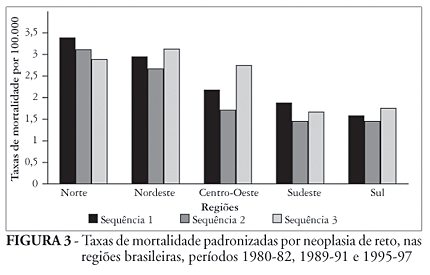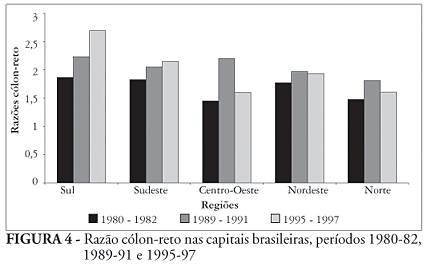BACKGROUND: In Brazil, colorectal tumors are among the five more important sites of neoplasms, for both sexes, in terms of mortality. The etiology of colon and rectal cancer is complex and some of the factors involved in its genesis are related to diet. Brazilian geographic regions present heterogeneous alimentary profiles, that could be influencing the distribution of the mortality rates for these tumors. OBJECTIVE: To describe the patterns of mortality from cancers of the colon and the rectum in Brazilian State capitals in the period 1980-1997. MATERIAL AND METHODS: Mortality data for individuals of both sexes, residents in Brazilian State capitals (except Palmas, Tocantins) was obtained from the Ministry of Health Mortality System (SIM/MS). We considered as death from colon and rectum cancers those whose underlying cause of death was coded as 153.0 to 153.9, 154.0 and 154.1, according to ICD 9, in the period 1980-95; C18.0 to C18.9, C19 and C20,according to ICD 10, in the period 1996-97. The trends of the standardized mortality rates from colon and rectum cancer were analyzed through linear regression models. RESULTS: The highest standardized mortality rates for colorectal cancer were observed in the South and Southeastern regions and varied between 8,0 and 10,7/100000 inhabitants. Porto Alegre (11,9), São Paulo (10,8) and Rio de Janeiro (9,6) presented the greatest rates among the State capitals in the study period. In the South region, rates of mortality for Porto Alegre and Florianópolis presented an increasing trend in the study period and the same behavior was observed for São Paulo and Vitória in the Southeastern region. Brasilia and the other capitals of the Midwest, with the exception of Goiânia, showed a tendency of increment of the mortality rates. Among the capitals of the North and Northeast regions, an increasing trend of mortality was observed in Rio Branco and Fortaleza. The separate analysis of the mortality rates for tumors of the colon and for tumors of the rectum showed a similar pattern, with higher values being observed for colon neoplasia. DISCUSSION: Regional differences in the mortality rates for colon and rectum neoplasias have been discussed for different authors, who point to the contribution of cultural and alimentary habits, and differences of life style and socioeconomic status to this heterogeneity, besides other aspects related to access to health services and quality of hospital care and preventive services. These factors must be considered in the evaluation of the differences observed in Brazilian capitals. Although the State capitals situated in South and Southeastern regions presented higher rates than the others, mortality rates of Porto Alegre (9,8/100.000) and Rio de Janeiro (9,0/100.000), in period 1983- 85, were about three times lower than those observed in the United States, Canada and France, in 1985. The sex distribution pattern of the mortality rates in Brazilian capitals was not uniform, with higher rates in men. We observed a trend of increment of the mortality rates of colorectal cancer in all Brazilian regions, similar to that was observed in some countries of the world, although with different gradients. CONCLUSIONS: The standardized mortality rates for colon and rectum neoplasias presented important regional differences among Brazilian State capitals. The highest rates were observed in the South and Southeastern regions. A trend of increment of the standardized mortality rates for cancers of the colon and the rectum was observed in all Brazilian regions in the period 1980-1997.
Colonic neoplasms; mortality; Rectal neoplasms; mortality; Brazil







